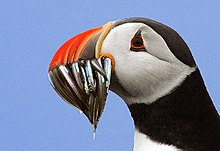Sand eel

Sand eel or sandeel is the common name used for a considerable number of species of fish. Most of them are sea fish of the genera Hyperoplus (greater sand eels), Gymnammodytes or Ammodytes[1]. Many species are found off the western coasts of Europe from Spain to Scotland, and in the Mediterranean and Baltic seas.
The three genera listed above all fall within the family Ammodytidae, the sand lances. Members of these genera found in other oceans are not usually called sand eels, and species from other parts of the world are known as sand eels are usually less closely related. None of the sand eels is related to the true eels.
Sand eels are an important food source for seabirds, including puffins and kittiwakes.
Habitat
The preferential habitat for sand eels is a seabed floor, with a relatively smooth bottom of gravelly sand; an example of this prime habitat is the floor of the Sea of the Hebrides.
Commercial fishing
Traditionally, they have been little exploited for human food, but are a major target of industrial fishing for animal feed and fertilizer.[2]
Increasing fishing for them is thought to be causing problems for some of their natural predators, especially the auks which take them in deeper water. They are also tied as flies to catch fish.
An instance of this was the RSPB report linking a population crash of seabirds in the North Sea to fishing for sand eels.[3][4] This led to political pressure for the closure of this fishery; the seabird populations subsequently improved.[5]
See also
References
- ^ "Ammodytes tobianus Linnaeus, 1758". WoRMS taxon details. World Register of Marine Species. Archived from the original on 2020-11-14. Retrieved 2020-11-14.
{{cite web}}: Unknown parameter|deadurl=ignored (|url-status=suggested) (help) - ^ Daunt, Francis; Wanless, Sarah; Greenstreet, Simon P.R.; Jensen, Henrik; Hamer, Keith C; Harris, Michael P (2008). "The impact of the sandeel fishery closure on seabird food consumption, distribution, and productivity in the northwestern North Sea". Canadian Journal of Fisheries and Aquatic Sciences. 65 (3): 362–381. doi:10.1139/f07-164. ISSN 0706-652X.
- ^ Carroll, Matthew J.; Bolton, Mark; Owen, Ellie; Anderson, Guy Q.A.; Mackley, Elizabeth K.; Dunn, Euan K.; Furness, Robert W. (2017). "Kittiwake breeding success in the southern North Sea correlates with prior sandeel fishing mortality". Aquatic Conservation: Marine and Freshwater Ecosystems. 27 (6): 1164–1175. doi:10.1002/aqc.2780. ISSN 1052-7613.
- ^ "Sandeels and seabirds: Protecting our seas in post-Brexit waters". The RSPB. 2017-06-14. Archived from the original on 2020-11-14. Retrieved 2020-11-14.
Tracking data of individual breeding kittiwakes by RSPB scientists indicates that the most productive sandeel fishing grounds, an area known as the Dogger Bank, overlap with foraging areas of kittiwakes from eastern English colonies, raising the prospect that the fishery could adversely affect the birds' populations.
{{cite web}}: Unknown parameter|deadurl=ignored (|url-status=suggested) (help) - ^ "NGOs Applaud UK Governemtn Proposal to Close Dogger Bank to Fishing". News. Blue Marine Foundation. Archived from the original on 2020-11-14. Retrieved 2020-11-14.
If fully protected, the Dogger Bank protected area will provide a refuge for over fished and endangered species like the common state and angleshark. Important keystone fish such as sandeels can recover to feed greater numbers of fish, seabirds porpoises and seals.
{{cite web}}: Unknown parameter|deadurl=ignored (|url-status=suggested) (help)
External links
